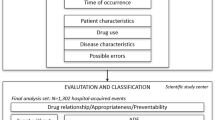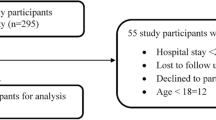Summary
As part of a high-intensity monitoring study of drug events as the cause of admission to departments of internal medicine, the effect of an educational intervention programme was studied. Two departments were included, one specialising in geriatrics and one that received patients by non-selected referral. The series consisted of 607 consecutive admissions studied before and 703 after the intervention. The drug events considered were adverse drug reactions and dose-related therapeutic failures, mainly due to non-compliance.
A modest, statistically non-significant decrease in drug related hospital admissions (DRH) was seen, from 14% before to 13% after the intervention period. However, DRHs classified as definitely avoidable showed the significant decrease of 83%.
There was no apparent relationship between the topics selected for the intervention programme and changes in the pattern of DRHs. No relationship between alterations in sales data and hospital admissions caused by a given drug could be demonstrated. A blinded external evaluation of case abstracts did not disclose any significant shift in the investigators' assessments.
The intervention may have had an non-specific effect on avoidable DRHs.
Similar content being viewed by others
Reference
Seidl LG, Thornton GE, Smith JW, Cluff LE (1966) Studies on the epidemiology of adverse drug reactions. Bull John Hopkins Hosp 119: 299–315
Miller RR (1974) Boston Collaborative Drug Surveillance Program. Hospital admissions due to adverse drug reactions. Arch Int Med 134: 219–222
Bergman U, Wiholm B-E (1981) Drug related problems causing admission to a medical clinic. Eur J Clin Pharmacol 20: 193–200
Hallas J, Gram LF, Grodum E, Damsbo N, Brøsen K, Haghfelt T, Harvald B, Beck-Nielsen J, Worm J, Jensen KB, Davidsen O, Frandsen NE, Hagen C, Andersen M, Frølund F, Kromann-Andersen H, Schou J (1992) Drug related admissions to medical wards. A population based survey. Br J Clin Pharmacol 33: 61–68
Italian Group on Intensive Care Evaluation (1987) Epidemiology of adverse drug reactions in intensive care units. A multicentre prospective survey. Eur J Clin Pharmacol 31: 507–512
Hallas J, Harvald B, Gram LF, Grodum E, Brøsen K, Haghfelt T, Damsbo N (1990) Drug related hospitalisations. The role of definitions and intensity of the data collection, and the possibility of prevention. J Intern Med 228: 83–90
Hallas J, Haghfelt T, Gram LF, Grodum E, Damsbo N (1990) Drug related admissions to a cardiology department; frequency and avoidability. J Intern Med 228: 379–384
Hallas J, Jensen KB, Grodum E, Damsbo N, Gram LF (1991) Drug related admissions to a department of medical gastroenterology. The role of self-medicated and prescribed medicine. Scand J Gastroenterol 26: 174–180.
Hallas J, Worm J, Beck-Nielsen J, Gram LF, Grodum E, Damsbo N, Brøsen K (1991) Drug related events and drug utilisation in patients admitted to a geriatric hospital department. Dan Med Bull 38: 417–420
Anonymous. (1989) Drug comsumption in Denmark 1988. Dansk Lægemiddelstatistik 1989. Strødamvej 50B, DK-2100 Ø, Denmark
Anonymous. (1990) Drug comsumption in Denmark 1989. Dansk Lægemiddelstatistik 1990. Strødamvej 50B, DK-2100 Ø, Denmark
Nordic Council of Medicine (1985) Nordic drug index with defined daily doses. Nordic Statistics on Medicine 1981–1983, part 2
Morris JA, Gardner MJ (1989) Calculating confidence intervals for relative risks, odds ratios, and standardised ratios and rates. In: Gardner JA, Altman DG (eds) Statistics with confidence. BMJ, edition, London 1989: 50–63
Hawkey CJ, Hodgson S, Norman A, Daneshmend TK, Garner ST (1990) Effect of reactive pharmacy intervention on quality of hospital prescribing. BMJ 300: 986–990
15.Ray WA, Blazer DG, Shaffner W, Federspeil CF, Fink R (1986) Reducing the long-term diazepam prescribing in office practice. A controlled trial of educational visits. JAMA 256: 2536–2539
Owens NJ, Sherburne NJ, Silliman RA, Fretwell MD (1990) The senior care study. The optimal use of medications in acutely ill older patients. J Am Geriatr Soc 38: 1082–1087
Buck CR, White KL (1974) Peer review, impact of a system based on billing claims. N Engl J Med 291: 877–983
Diwan V, Angunawela I, Tomson G (1989) A method to evaluate effect of drug information, randomisation in groups: an experience from Sri Lanka. Eur J Clin Pharmacol 36 [Suppl]: 102A
Gurwitz JH, Soumerai SB, Avorn J (1990) Improving medication prescribing and utilisation in the nursing home. J Am Geriatr Soc 38: 542–552
FitzGerald GR, Delaney E, Cushen M, FitzGerald MG (1989) Diuretic associated hopykalemia in hospital admission. Res Clin Forums 11: 49–53
Williamson DH, Cooper JW, Kotzan JA (1984) Consultant pharmacist intervention on antihypertensive therapy in a geriatric long-term facility. Hosp Formul 19: 123–128
Ott P, Hansen PB, Dalhoff KP, Loft SH, Poulsen HE (1990) Consumption of overdose and fatal poisoning with analgesics in Denmark 1979–86 (in Danish with an English abstract). Ugeskr Laeger 152: 250–252
Jick H (1974) Drugs — remarkably nontoxic. N Engl J Med 291: 824–828
Louik C, Lacoutre PG, Michell AA, Kauffman R, Lovejoy FH, Yaffe SJ. Shapiro S (1985) A study of adverse reaction algorithms in a drug surveillance program. Clin Pharmacol Ther 38: 183–187
Author information
Authors and Affiliations
Rights and permissions
About this article
Cite this article
Hallas, J., Harvald, B., Worm, J. et al. Drug related hospital admissions. Eur J Clin Pharmacol 45, 199–203 (1993). https://doi.org/10.1007/BF00315383
Received:
Accepted:
Issue Date:
DOI: https://doi.org/10.1007/BF00315383




